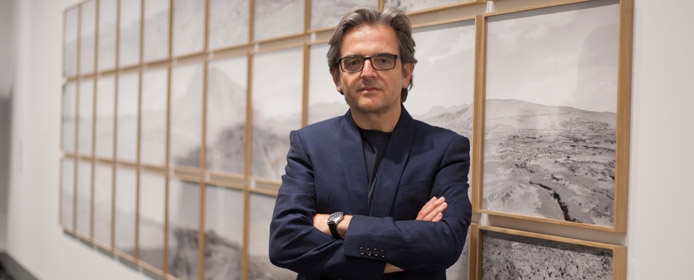The museum inaugurates the photographic exhibition Nitrate by Xavier Ribas on the exploitation of nitrate in Chile.
The project of the Catalan artist is a co-production with the Museu d'Art Contemporani de Barcelona (MACBA), fruit of his work of research with a multidisciplinary and international team.

The Museum inaugurates the photographic exhibition Nitrate, by Xavier Ribas, which will be open until March 6 next year. The sample is made up of 11 photographic series, texts, objects and videos installed on the entire floor -1 of the building, about 1,300 m2, almost half of the exhibition space of the Museum.
Co-produced with the Museu d'Art Contemporani de Barcelona (MACBA), at partnership with Bluecoat Liverpool's Centre for the Contemporary Arts, and with the support of Acción Cultural Española (AC/E) and the Arts & Humanities Research Council, it has been curated by Carles Guerra, recently appointed director of the Fundación Tàpies.
First presented at MACBA in June 2014 and at Liverpool's Bluecoat from April to July this year, the large body of work obtained from programs of study and photographs taken in Chile, Great Britain, Spain and the United States are now on display at the Museum.
Ribas' latest work is presented in the Museum's galleries in a different way than the one shown at MACBA. "Here the visitor is placed in a very interesting position of play; it is a relational photography that never ceases to produce different senses and meanings," emphasizes Carles Guerra. Given the presence of various photographic series in the form of a grid, the artist argues that "the grid has an archaeological character, of penetration into the past; it is about structuring a space from a fragmentation of images, as if it were a puzzle, to express an idea," explains Xavier Ribas.
The origin of Nitrate
It arises from the participation of Xavier Ribas in the project Tender Bridges of the Museum, where he made one of the series that includes the exhibition: Concrete Geographies (Ceuta and Melilla).
Since 2009, Xavier Ribas has dedicated his photographic internship to studying the natural history of this mineral in response to the 19th century photographic album Oficina Alianza y Puerto de Iquique 1900, which is part of the University of Navarra Museum Collection and is present at sample, and which caught his attention. "I have historically dressed this album, giving it a context that it didn't have before," explains Xavier Ribas. "Oficina Alianza y Puerto de Iquique 1900 is the knot of this project, a knot coherent with 19th century photography," adds Carles Guerra.
The project traces the journey of Chilean nitrate from its natural mineral state , processed in the "offices" of the Atacama Desert, through its transportation as a commodity and its listing as a stock exchange security, to finally becoming part of the material and symbolic heritage of London estates and the British countryside. It documents geographically disparate but historically connected landscapes (the remote saltpeter fields and the financial districts of the metropolis), as well as archives and artifacts.
Nitrate explores the bequest of Chilean sodium nitrate, a non-renewable natural resource that was extensively mined by foreign capitalist companies in northern Chile between 1870 and 1920. These companies, mainly British, transformed a part of the Atacama Desert into an industrial landscape in a relatively short period of time. Sodium nitrate was a very important commodity that was traded mainly as a natural fertilizer, but was also used in the manufacture of explosives, making it a crucial ingredient in the increase of both life and death.
A work multidisciplinary
Xavier Ribas has made this project together with Louise Purbrick, researcher in History at the University of Brighton, and the Chilean photographer Ignacio Acosta, student of doctorate, thus introducing the study and the research to the processes of creation and artistic production. For this reason, "this Museum, being a university, is ideal for presenting Nitrate," the curator points out.
The diversity of practices employed, interests, institutions, contributions from research in libraries and archives, interviews and fieldwork travel, as well as the collection of materials, has generated a confluence of areas of knowledge, methods and modes of communication that go beyond the limits of photography as a medium.
This fact leads us to consider Nitrate as a documentary device; that is, a group of works that can be interpreted as a whole, autonomously. Most of the works in Nitrate are, in the artist's words, "a constellation of materials around the mineral", combining photography with images from file, information, stories, news, inventories, lists and even objects.
Series "Concrete Geographies (Ceuta and Melilla)".
After his first two decades of work, Xavier Ribas was recognized as a photographer committed to the geographies of withdrawal: suburban areas, roadsides where prostitution is practiced or where there are spaces transformed into sanctuaries that identify the site of fatal traffic accidents, borders of all subject and temporary settlement areas where human presence is the object of expulsion policies. In his project for Tender Puentes, Geografías concretas (Ceuta y Melilla), Ribas approaches the representation of the contemporary European landscape based on two photographic journeys along the border fences of Ceuta and Melilla. In the two photographic grids of 24 photographs each, the artist visualizes the landscape defined by these fences that delimit at once a colonial/national border between Spain and Morocco, an economic border between Europe and Africa, a geopolitical border between North and South and a religious border between Christianity and Islam. "The border fences of Ceuta and Melilla are to the European landscape of the 21st century what bridges, tunnels and railways were to the landscape of the second half of the 19th and early 20th centuries," explains the artist.
